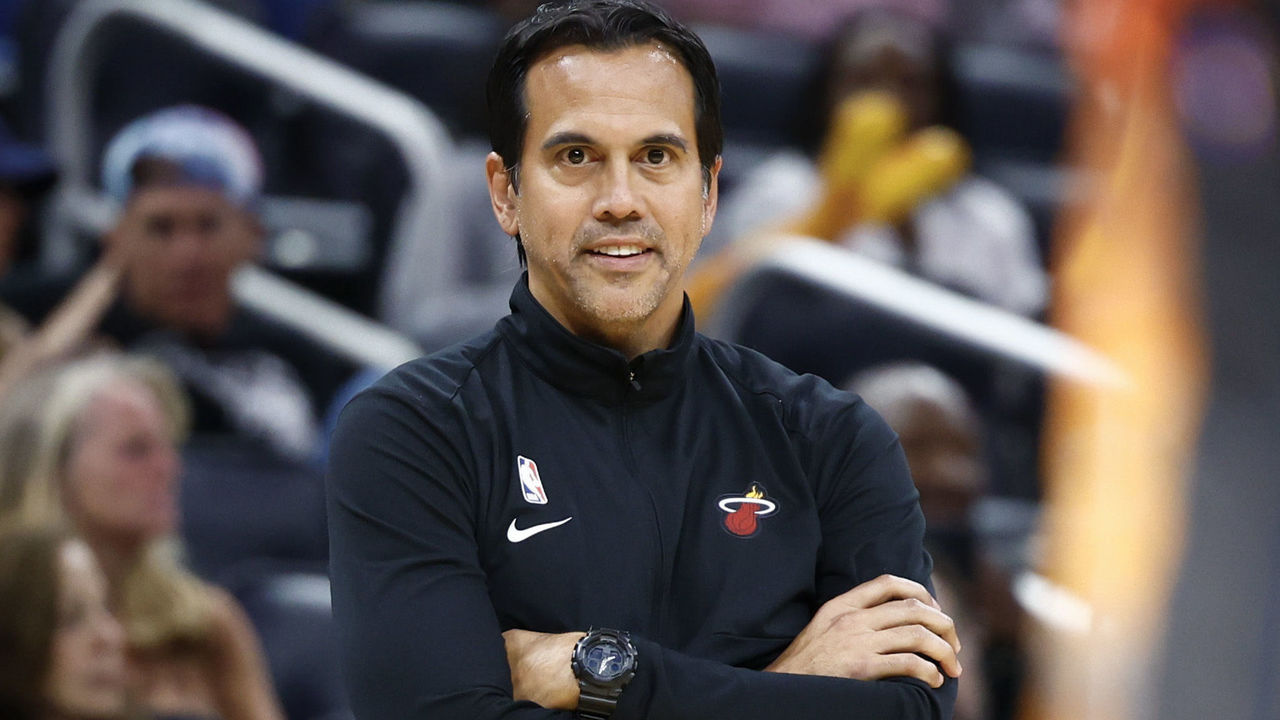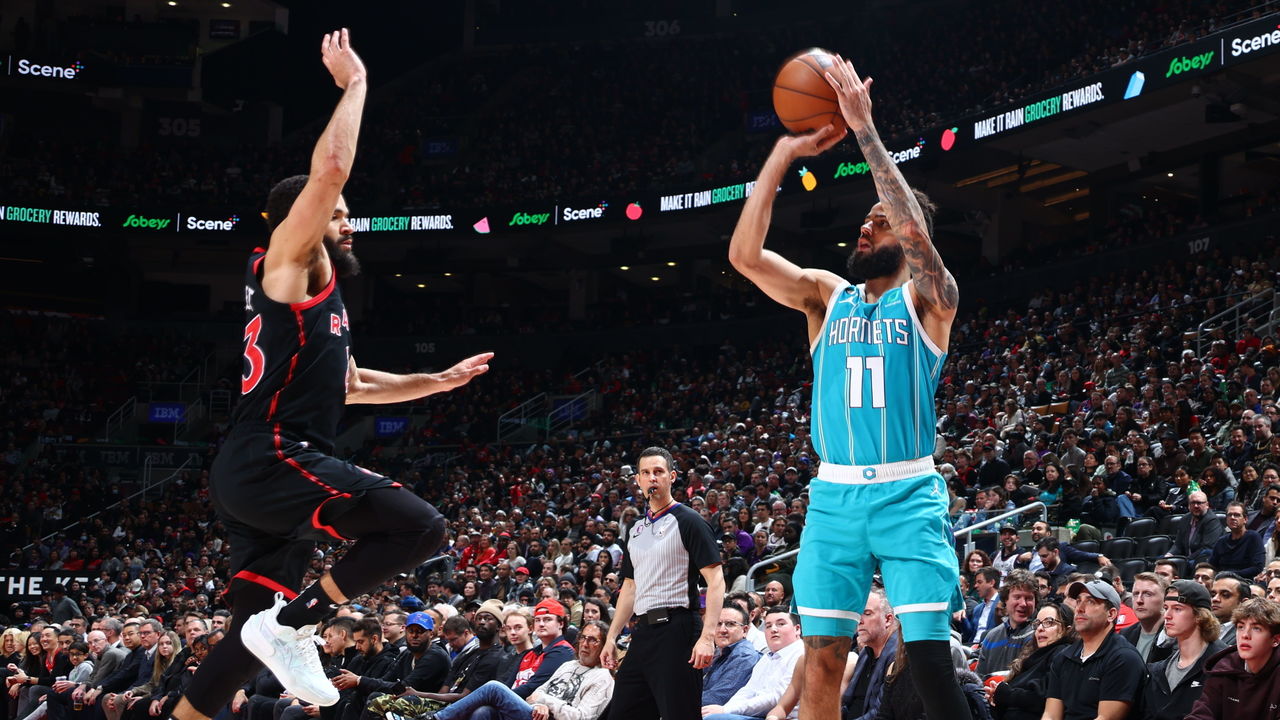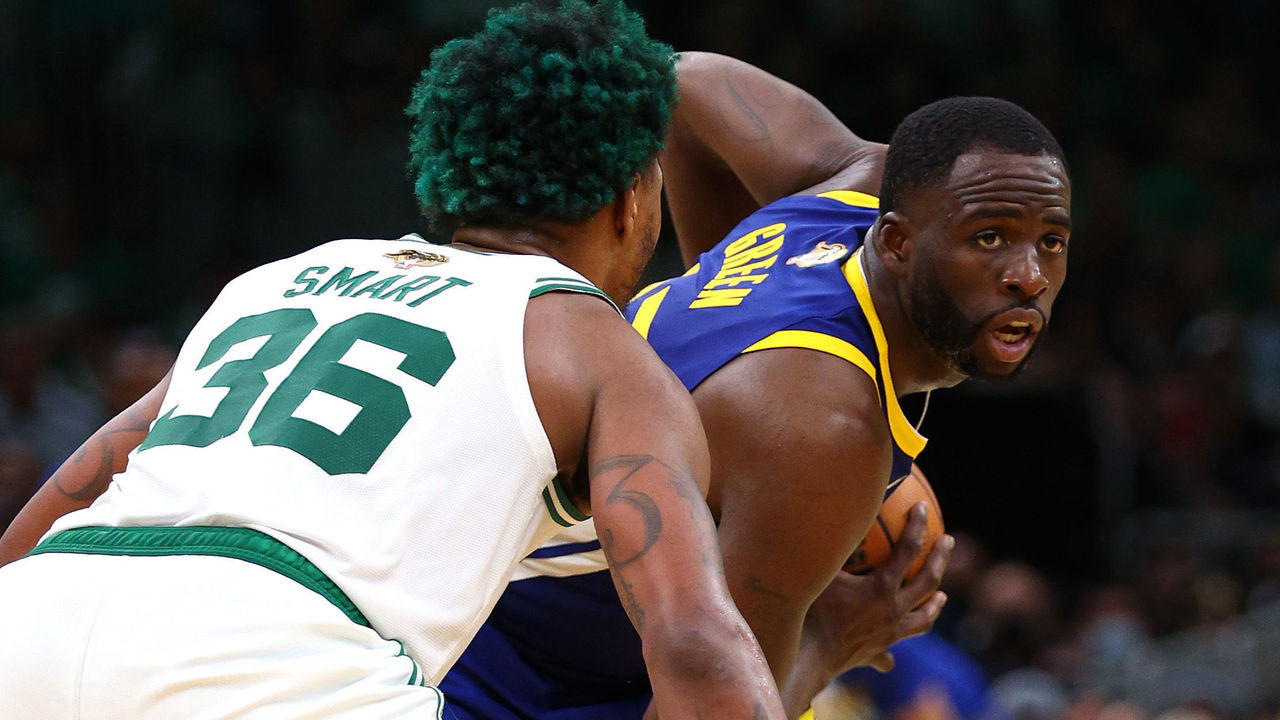Trends to watch: The delicate balance between interior and 3-point defense
Now that it's 2023, we're looking at some stylistic trends that could define the NBA in the calendar year to come. Today: the tricky balance of rim defense and 3-point defense.
Previously: The rise of offensive rebounding | The viability of tall ball
There are plenty of reasons why offensive efficiency is at an all-time high, and one of the most frequent causes you'll hear cited is the proliferation of 3-point shooting. But while that trend indeed contributed massively to lifting scoring out of its early-2000s nadir, it doesn't quite explain why this particular year represents the peak.
After two decades of steep ascent, 3-point volume has been stable for four years now; 3-pointers accounted for 35.5% of all shot attempts (including those on which fouls occurred) in 2019-20, and they've accounted for 35.6% this season, per Cleaning the Glass. It's not like players are getting more accurate from deep, either. League-average 3-point percentage was 35.8% in 2019-20, and it's 35.9% this season. So, 3-point shooting on its own can't account for the league's median offensive rating jumping from 110.4 to 113.2 over that four-year span.
It's actually inside the arc, and especially around the basket, that offenses have collectively become so much more difficult to stop. In the aforementioned time frame, league-average shooting has leapt from 63.6% to 66.5% at the rim and from 40% to 43.5% in floater range. After hitting an 18-year low last season, rim volume has ticked back up this year. The driving game has never been more effective, with the median team converting drives directly into points at a 58% clip - by far the highest mark in the NBA Advanced Stats database and way up even from last season (54.6%). The floater continues to rise in prominence and potency. Post-ups, though increasingly rare, are more efficient than they've ever been.
There's clearly an interplay between the threat of 3-pointers and the threat of interior scoring - two forces that amplify one another and leave defenses to pick one of two increasingly deadly poisons. On top of drivers having cleaner lanes and post players seeing fewer hard double-teams, offenses have gotten better about diverting help with weak-side activity like exit screens and shake action that preys on defenses' rational fear of the 3-ball.

Every defense has to make concessions and decide what it is and isn't willing to live with. How does one, in this day and age, decide which part of the court to prioritize?
"I know I can speak for a lot of coaching staffs out there: We're all trying to figure it out," Miami Heat coach Erik Spoelstra told theScore. "The way this league is now, from when I came into it in the '90s, it's so much different. The spacing, the skill level, the way it's officiated, the way teams can go on 15-to-20-point runs like that (snaps fingers). You take away something, and there's unintended consequences that lead to other things. So, we're all trying to figure it out."
Under Mike Budenholzer, the Milwaukee Bucks were one of the first teams during the modern scoring boom to actively de-emphasize 3-point deterrence to go all-in on protecting the paint. They figured that between Brook Lopez and Giannis Antetokounmpo, they could suppress opposing teams' interior scoring to the point the math worked out in their favor. They were right. Despite surrendering more threes than any other team, the Bucks led the league in defensive efficiency in Budenholzer's first two years at the helm and rode that defense to a championship in his third.
Their success influenced other teams, including Spoelstra's Heat and Nick Nurse's Toronto Raptors, though those teams deployed dramatically different schemes in order to craft comparable defensive shot profiles. Where the Bucks used deep drop coverage padded by weak-side tagging, other teams used aggressive nail help, digs from the wing, backline rotations from both corners, and various zones and hybrid zones to force the ball away from the middle of the floor.
Because they've been so good at rim suppression, the Heat have been a top-10 defense in each of the last four seasons (including top-five in the last two) despite ranking 29th, 30th, 30th, and 29th in 3-point frequency allowed. But that doesn't mean Spoelstra is satisfied with the shots his team is giving up.

"I would never say that we're accepting it, you know, getting lit up behind the three," Spoelstra said. "A lot of it ends up being in transition, and that's where we're trying to shore up some of our defense. Dribble penetration invariably leads to a lot of open threes, and we're working on that as well."
"I would like to take away both. I would prefer that," Philadelphia 76ers coach Doc Rivers chuckled early in the season, back when his team was surrendering boatloads of threes before completely turning things around. "You have to make a choice, obviously. But I don't like, honestly, the amount of threes we've given up. The league just shoots too well now to allow the amount that we've given up. We stop them at the rim with our size, but we're committing an extra guy, and that's where the ball is coming out."
This year's Bucks are discovering that they don't necessarily have to choose. They've made a point of keeping off-ball perimeter defenders home on spot-up shooters rather than tagging or pinching in from the wings and the corners the way they'd done in the past. The upshot: They're still allowing the fourth-lowest rate of opponent rim attempts but are now also allowing the ninth-lowest rate of opponent threes. Achieving that balance may be a feat that's specific to their personnel, though two other teams (the Boston Celtics and, surprisingly, the Washington Wizards) also rank top-10 in suppressing shots from both locations, per Cleaning the Glass.
The New York Knicks are one team that might realistically be able to mimic the Bucks' philosophical shift. They defend fairly similarly to the way Milwaukee used to - pinching aggressively from the wings, sending help crashing into the middle from the corners, and consequently allowing the league's fourth-highest rate of threes. Mitchell Robinson isn't exactly Lopez, and Julius Randle is certainly no Antetokounmpo. But with the way Robinson can alter shots around the basket with his length and bounce, and the way Randle can provide cover on the glass when Robinson leaps out to contest shots, you'd think New York could get by with a bit less supplemental help.

However, that doesn't appear to be in the cards for coach Tom Thibodeau and Co.
"Philosophically, if you're asking that question, the marker that I look at in general is: Are you protecting the paint first?" Thibodeau told theScore. "Most offenses are still geared toward attacking the restricted. So that's your first priority: get back, get set. Then mark your shooters. You're going to be tested in a lot of different ways. I think the skill level of the players is at an all-time high, so we know we're going to be tested. Everyone being tied together and how connected you are is a big part of playing defense in this league."
It's worth noting that the Knicks do a good job of helping and recovering without getting their assignments scrambled, which is the biggest challenge of playing their style of defense. Even in the face of statistical evidence to the contrary, conventional wisdom suggests that teams should be able to influence opponents' long-range accuracy by dictating the quality of those looks and the shooters taking them. The Knicks have ranked sixth or better in opponent 3-point percentage in all three of Thibodeau's seasons at the helm, which feels like a pattern that can't entirely be chalked up to luck.
Nurse has long believed that the Raptors could accomplish the same thanks to their length, speed, and hair-on-fire closeouts, especially given that their scheme makes a point of forcing the ball out of opposing stars' hands. One of his explanations for his team's defensive slide this season is that he doesn't feel those closeouts have had the same ferocity.
"Protecting the paint and the rim first, but being really good at being able to contest (threes)," is how Nurse described the team's overarching principles. "We give up a high volume of threes normally but a fairly low percentage … which means we're contesting pretty hard. We haven't contested nearly as well (this season)."

The Raptors have indeed gotten burned from beyond the arc worse than they did last season, with opponents shooting nearly 38% (up from 36%), but the bigger problem has been their inability to stop teams at the basket. Without a dominant backline anchor in recent years, they've had to take an all-hands-on-deck approach to rim deterrence. That was relatively effective last season when they offset the league's 22nd-ranked defensive field-goal percentage at the rim by allowing the 13th-lowest frequency of shots from that area. This season, they're bottom-10 in both volume and efficiency allowed inside the restricted area, per Cleaning the Glass.
To the extent that closeouts have been an issue, it's been more about a lack of cohesion than a lack of effort - like two players closing out to the same shooter or poor secondary rotations when closeouts get attacked, which is compounded by their lack of an imposing "final boss" to confront drivers at the rim. Fred VanVleet's regression as a point-of-attack defender has exposed the perils of a frenetic scheme that exacts a heavy mental and physical toll and leaves very little margin for error. Last season, I explored some of the downsides of playing center-less, and no team has felt those consequences more acutely this year than Toronto.
The Cleveland Cavaliers, conversely, have Jarrett Allen and Evan Mobley joining forces to give everyone around them a comforting security blanket. The Cavs of the last two years have allowed a higher-than-average rate of opponent rim shots essentially by design and been a top-five defense both years because they've been able to minimize opponent threes while their big-man tandem snuffs out interior attempts. They rank second in defensive efficiency this season, despite starting two 6-foot-1 guards at the point of attack.
The restricted area remains the most valuable slice of real estate on the court, and despite Marcus Smart's convention-bucking Defensive Player of the Year win last season, rim-protectors remain the league's most important defenders. Of course, perimeter defense is still integral to the whole operation. For as good as Allen and Mobley are, the Cavs wouldn't be where they are if they hadn't also gotten tremendous defensive effort from Donovan Mitchell and Darius Garland.
"They feel more confident that they can be more aggressive (with Allen and Mobley behind them), but they're just as important," Cavs coach J.B. Bickerstaff told theScore. "If they're undisciplined, and our big guys are always playing two-on-ones, the good teams are going to figure out the advantage. If they're doing their job and fighting through screens and staying in front of their man, the big guy can just be the presence and clean up on the glass, which is huge. If your big guys are always under duress, and now they're getting fouls, they're going to stop doing their jobs."

Sometimes the best interior defense is simply good perimeter defense. That's why Smart's DPOY award, disputed though it may have been in some corners, still holds plenty of merit. While he serves mainly as a point-of-attack defender, his ability to contain dribble penetration, stymie short rolls as a low man, and handle big men on switches makes him a deterrent at all three levels. The Celtics allowed a dramatically lower rate of paint shots with him on the floor last season.
The Bucks benefit from having the monstrous Lopez and Antetokounmpo duo manning the backline, but they wouldn't be able to carry out their new defensive mandate if on-ball defenders like Jrue Holiday and Jevon Carter weren't so good at fighting through screens and pushing opposing ball-handlers inside the arc. Milwaukee defenders actually go under screens more often than any team in the league, according to Second Spectrum. That's a good way to keep the ball from breaching the paint, but it would also risk surrendering a lot of clean pull-up threes if those guys weren't so adept at ducking under without fully losing contact with ball-handlers.
So, there are a lot of different ways to approach the conundrum of trying to slow down a multi-pronged NBA offense in 2023. It'll be interesting to see what types of schematic blueprints emerge in the coming year beyond the obvious "have good defenders."
HEADLINES
- Kerr: Timeout blowup with Draymond 'not my finest hour'
- Tatum-less Celtics are inspiring, Cavs are not, new anti-tanking measures
- NBA Christmas Day picks: Spurs-Thunder rematch headlines holiday card
- Former NBA 2nd-round pick Nnaji joins Baylor with immediate eligibility
- Spurs storm past Thunder for 2nd win over OKC in 10 days